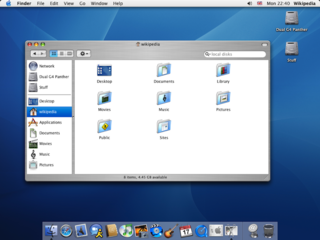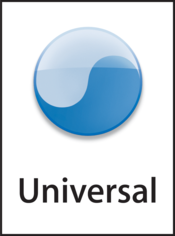A binary prefix is a unit prefix for multiples of units. It is most often used in data processing, data transmission, and digital information, principally in association with the bit and the byte, to indicate multiplication by a power of 2. As shown in the table to the right there are two sets of symbols for binary prefixes, one set established by International Electrotechnical Commission (IEC) and several other standards and trade organizations using two-letter symbols, e.g. Mi indicating 1048576 with a second set established by semiconductor industry convention using one-letter symbols, e.g., M also indicating 1048576.
The kilobyte is a multiple of the unit byte for digital information.
The megabyte is a multiple of the unit byte for digital information. Its recommended unit symbol is MB. The unit prefix mega is a multiplier of 1000000 (106) in the International System of Units (SI). Therefore, one megabyte is one million bytes of information. This definition has been incorporated into the International System of Quantities.
Hierarchical File System (HFS) is a proprietary file system developed by Apple Inc. for use in computer systems running Mac OS. Originally designed for use on floppy and hard disks, it can also be found on read-only media such as CD-ROMs. HFS is also referred to as Mac OS Standard, while its successor, HFS Plus, is also called Mac OS Extended.

Mac OS X Panther is the fourth major release of macOS, Apple's desktop and server operating system. It followed Mac OS X Jaguar and preceded Mac OS X Tiger. It was released on October 24, 2003, with the retail price of US$129 for a single user and US$199 for a five user, family license.

System 7, codenamed "Big Bang", and also known as Mac OS 7, is a graphical user interface-based operating system for Macintosh computers and is part of the classic Mac OS series of operating systems. It was introduced on May 13, 1991, by Apple Computer It succeeded System 6, and was the main Macintosh operating system until it was succeeded by Mac OS 8 in 1997. Current for more than six years, System 7 was the longest-lived major version series of the classic Macintosh operating system. Features added with the System 7 release included virtual memory, personal file sharing, QuickTime, QuickDraw 3D, and an improved user interface.
StuffIt is a discontinued family of computer software utilities for archiving and compressing files. Originally produced for the Macintosh, versions for Microsoft Windows, Linux (x86), and Sun Solaris were later created. The proprietary compression format used by the StuffIt utilities is also termed StuffIt.

Norton Utilities is a utility software suite designed to help analyze, configure, optimize and maintain a computer. The latest version of the original series of Norton Utilities is Norton Utilities 16 for Windows XP/Vista/7/8 was released 26 October 2012.

The spinning pinwheel is a type of throbber or variation of the mouse pointer used in Apple's macOS to indicate that an application is busy.

Mac OS X Leopard is the sixth major release of macOS, Apple's desktop and server operating system for Macintosh computers. Leopard was released on October 26, 2007 as the successor of Mac OS X 10.4 Tiger, and is available in two editions: a desktop version suitable for personal computers, and a server version, Mac OS X Server. It retailed for $129 for the desktop version and $499 for Server. Leopard was superseded by Snow Leopard in 2009. Leopard is the final version of macOS to support the PowerPC architecture as Snow Leopard functions solely on Intel based Macs.

The universal binary format is a format for executable files that run natively on either PowerPC or Intel-manufactured IA-32 or Intel 64 or ARM64-based Macintosh computers. The format originated on NeXTStep as "Multi-Architecture Binaries", and the concept is more generally known as a fat binary, as seen on Power Macintosh.

Disk Utility is a system utility for performing disk and disk volume-related tasks on the macOS operating system by Apple Inc.
The Apple Network Server (ANS) was a line of PowerPC-based server computers designed, manufactured and sold by Apple Computer, Inc. from February 1996 to April 1997. It was codenamed "Shiner" and originally consisted of two models, the Network Server 500/132 and the Network Server 700/150, which got a companion model, the Network Server 700/200 with a faster CPU in November 1996.

TestDisk is a free and open-source data recovery utility that helps users recover lost partitions or repair corrupted filesystems. TestDisk can collect detailed information about a corrupted drive, which can then be sent to a technician for further analysis. TestDisk supports DOS, Microsoft Windows, Linux, FreeBSD, NetBSD, OpenBSD, SunOS, and MacOS. TestDisk handles non-partitioned and partitioned media. In particular, it recognizes the GUID Partition Table (GPT), Apple partition map, PC/Intel BIOS partition tables, Sun Solaris slice and Xbox fixed partitioning scheme. TestDisk uses a command line user interface. TestDisk can recover deleted files with 97% accuracy.
A sparse image is a type of disk image file used on macOS that grows in size as the user adds data to the image, taking up only as much disk space as stored in it. Encrypted sparse image files are used to secure a user's home directory by the FileVault feature in Mac OS X Snow Leopard and earlier. Sparse images can be created using Disk Utility.

Mac OS X Snow Leopard is the seventh major release of macOS, Apple's desktop and server operating system for Macintosh computers.

Gatekeeper is a security feature of the macOS operating system by Apple. It enforces code signing and verifies downloaded applications before allowing them to run, thereby reducing the likelihood of inadvertently executing malware. Gatekeeper builds upon File Quarantine, which was introduced in Mac OS X Leopard and expanded in Mac OS X Snow Leopard. The feature originated in version 10.7.3 of Mac OS X Lion as the command-line utility spctl. A graphical user interface was originally added in OS X Mountain Lion (10.8) but was backported to Lion with the 10.7.5 update.

macOS Sierra is the thirteenth major release of macOS, Apple Inc.'s desktop and server operating system for Macintosh computers. The name "macOS" stems from the intention to uniform the operating system's name with that of iOS, watchOS and tvOS. Sierra is named after the Sierra Nevada mountain range in California and Nevada. Its major new features concern Continuity, iCloud, and windowing, as well as support for Apple Pay and Siri.
Apple File System (APFS) is a proprietary file system developed and deployed by Apple Inc. for macOS Sierra (10.12.4) and later, iOS 10.3 and later, tvOS 10.2 and later, watchOS 3.2 and later, and all versions of iPadOS. It aims to fix core problems of HFS+, APFS's predecessor on these operating systems. APFS is optimized for solid-state drive storage and supports encryption, snapshots, and increased data integrity, among other capabilities.












